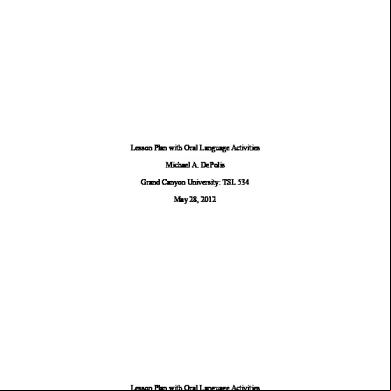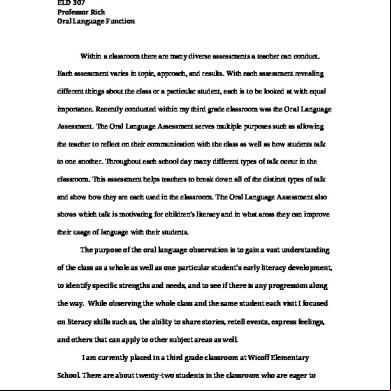Lesson Plan With Oral Language Activities 3h373k
This document was ed by and they confirmed that they have the permission to share it. If you are author or own the copyright of this book, please report to us by using this report form. Report 3b7i
Overview 3e4r5l
& View Lesson Plan With Oral Language Activities as PDF for free.
More details w3441
- Words: 506
- Pages: 5
Lesson Plan Running head: LESSON PLAN WTH ORAL LANGUAGE
Lesson Plan with Oral Language Activities Michael A. DePolis Grand Canyon University: TSL 534 May 28, 2012
Lesson Plan with Oral Language Activities
1
Lesson Plan
2
These are the four handouts used with my SIOP lesson: 1. Relative Frequency A survey is a way to collect information. The information collected is data. A tally chart is a useful tool for organizing the data as you collect it. Relative frequency is a measure of the probability that a member of the population will likely pick that answer choice. To calculate relative frequency, divide the number for each answer choice by the total number of answers given. Directions: Holly surveyed 20 fifth graders at a water park about their favorite water slide. She organized the results in a tally chart. Complete the tally and relative frequency column of the tally chart. Favorite Water Slide Slide The Big Splash The Zoom Flume Niagara Falls The Log Canal
Tally
Number 4 6 7 3 2. Collect Some Data
Relative Frequency
Directions: Think of a survey question to ask your classmates. The question should have 4 to 6 possible answers. For example, you could ask about a favorite school subject or a favorite type of music. Organize the results in a tally chart. Show relative frequency.
Did you ask enough students to represent all of the students in your school? Explain. 3. Representative Samples The people that you survey, or your sample, typically represent a larger group. It is important to find a sample that is representative of the larger group, or population.
Lesson Plan
3
Directions: tell whether or not the sample is representative of the population. Explain your answers. 1. Population: Sample:
students who ride the bus to school students standing at different bus stops in the morning
2. Population:
students at your elementary school
Sample:
the fifth grade boys’ basketball team
3. Population: Sample: 4. Population: Sample:
dog owners in your town 25 people attending a national dog show all of the teachers at Mandy’s school 20 teachers during parent teacher conferences 4. Biased Samples
Bias occurs when a sample does not represent the larger group. An unbiased sample will give accurate results. However, a biased sample can lead to invalid conclusions. Directions: Tell whether the sample in each survey is biased. Explain. 1. Meredith wants to know the favorite sport of students at her school. She surveys 30 students in the crowd during a home basketball game.
2. Michael wants to know the favorite outdoor activity of people who live in his home town. He surveys 25 people at a local golf course.
3. Gina wants to know the favorite school subjects of students at her school. She surveys 40 students as they wait in line to buy school lunch.
Lesson Plan
4
References Celce-Murcia, M. (Ed.). (n.d.). Teaching English as a second or foreign language (3rd ed.). Ohio: Cengage Learning. Miller, L. (2003). Developing listening skills with authentic materials. ESL Magazine, March/April 2003.
Lesson Plan
5
Lesson Plan with Oral Language Activities Michael A. DePolis Grand Canyon University: TSL 534 May 28, 2012
Lesson Plan with Oral Language Activities
1
Lesson Plan
2
These are the four handouts used with my SIOP lesson: 1. Relative Frequency A survey is a way to collect information. The information collected is data. A tally chart is a useful tool for organizing the data as you collect it. Relative frequency is a measure of the probability that a member of the population will likely pick that answer choice. To calculate relative frequency, divide the number for each answer choice by the total number of answers given. Directions: Holly surveyed 20 fifth graders at a water park about their favorite water slide. She organized the results in a tally chart. Complete the tally and relative frequency column of the tally chart. Favorite Water Slide Slide The Big Splash The Zoom Flume Niagara Falls The Log Canal
Tally
Number 4 6 7 3 2. Collect Some Data
Relative Frequency
Directions: Think of a survey question to ask your classmates. The question should have 4 to 6 possible answers. For example, you could ask about a favorite school subject or a favorite type of music. Organize the results in a tally chart. Show relative frequency.
Did you ask enough students to represent all of the students in your school? Explain. 3. Representative Samples The people that you survey, or your sample, typically represent a larger group. It is important to find a sample that is representative of the larger group, or population.
Lesson Plan
3
Directions: tell whether or not the sample is representative of the population. Explain your answers. 1. Population: Sample:
students who ride the bus to school students standing at different bus stops in the morning
2. Population:
students at your elementary school
Sample:
the fifth grade boys’ basketball team
3. Population: Sample: 4. Population: Sample:
dog owners in your town 25 people attending a national dog show all of the teachers at Mandy’s school 20 teachers during parent teacher conferences 4. Biased Samples
Bias occurs when a sample does not represent the larger group. An unbiased sample will give accurate results. However, a biased sample can lead to invalid conclusions. Directions: Tell whether the sample in each survey is biased. Explain. 1. Meredith wants to know the favorite sport of students at her school. She surveys 30 students in the crowd during a home basketball game.
2. Michael wants to know the favorite outdoor activity of people who live in his home town. He surveys 25 people at a local golf course.
3. Gina wants to know the favorite school subjects of students at her school. She surveys 40 students as they wait in line to buy school lunch.
Lesson Plan
4
References Celce-Murcia, M. (Ed.). (n.d.). Teaching English as a second or foreign language (3rd ed.). Ohio: Cengage Learning. Miller, L. (2003). Developing listening skills with authentic materials. ESL Magazine, March/April 2003.
Lesson Plan
5





